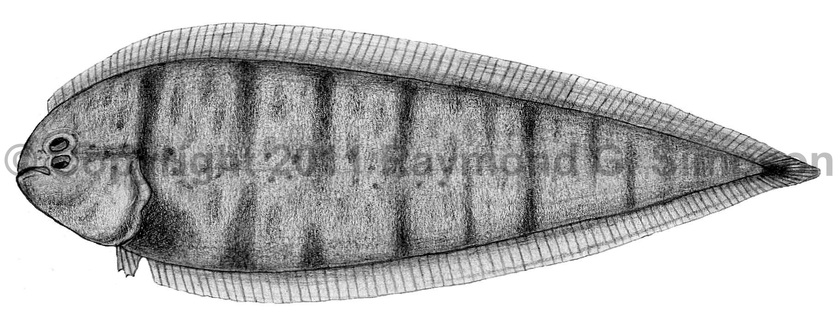
Common Name
Billy Kriete's Tonguefish
Year Described
Munroe, 1998
Identification
Dorsal Fin Rays: 89-95
Anal Fin Rays: 76-84
Pectoral Fin Rays: none
Pelvic Fin Rays: 4
Caudal Fin Rays: 12, rarely 11
Longitudinal Scale Rows: 80-100
Vertebrae: 50-53
Pterygiophore pattern (1st three interneural spaces): 1-3-2, rarely 1-3-3 or 1-4-2
Other diagnostic characters include: pupillary operculum absent, ocular side premaxilla with 3/4 to complete dentition, scales absent on blind side of dorsal and anal fins, ocular side lower jaw without fleshy ridge.
Color
Varying shades of brown with 5-8 irregular crossbands. Bands are darkest near fin bases and do not continue onto median fins. Fins are lightly motted with brown with a dark brown stripe on the posterior part of the dorsal and anal fin membranes. Caudal fin has a diffuse blotch on the base. Peritoneum is black. Blind side pale yellowish with no melanophores.
Size
Adults 56-105mm. Maximum 119mm.
Habitat
Outer continental shelf from 48-650m (mostly 200-380m) over mud bottoms.
Range Map

Range
Northwestern Atlantic from Nova Scotia to NC, and the southern Gulf of Mexico
References
Munroe, T.A. 1998. Systematics and ecology of western Atlantic tonguefishes (Symphurus: Cynoglossidae: Pleuronectiformes). Fish. Bull. 96(1):1-182.
Munroe, T. A. 2003. Bothidae (Pp. 1885-1895), Scophthalmidae (Pp. 1896-1897), Paralichthyidae (Pp. 1898-1921), Poecilopsettidae (Pp. 1922-1923), Achiridae (Pp. 1925-1933), Cynoglossidae (Pp. 1934-1959). In: Carpenter 2003 [ref.27082]. The living marine resources of the Western Central Atlantic v. 3.